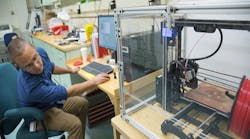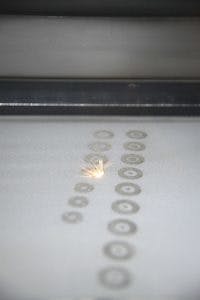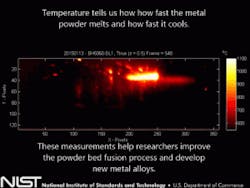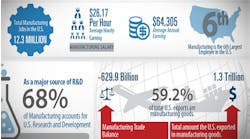Additive Manufacturing Equals Excitement
I research additive manufacturing, which some people call solid freeform fabrication, but most people know as 3-D printing. Additive manufacturing covers a wide range of processes that we can use to build parts and whole structures by strategically adding material only where we need it.
Building parts by adding material a bit at a time allows us to build geometries and features that we never could using traditional processes such as cutting, forging, or casting. For instance, with 3-D printing we can make complex, ultralightweight parts by building their internal structures using the least material possible. We can build these parts complete with winding internal passages for fluids to flow. And we can make them out of different materials depending on the properties we need them to have, such as rigidity or flexibility or the ability to conduct electricity or heat.
In the NIST Engineering Laboratory, of which I am a proud member of the Production Systems Group, we study the 3-D printing processes, such as Powder Bed Fusion (PBF) and Directed Energy Deposition (DED), used to build metal parts. PBF uses an energy beam (either laser or electron) to melt thin layers of powdered metal that are incrementally spread across a build surface (bed). When the part is completed, you have to excavate it from the powder bed like a dinosaur skeleton at an archeological dig.
DED also uses an energy beam to melt the metal, but instead of melting powder that has already been spread across the bed, metal in the form of powder or wire is fed into the beam, where it melts and fuses with previously deposited material. Unlike PBF, we can use DED to repair existing worn parts. We can also efficiently create a new part by first producing much of a part with conventional processes, such as casting or machining, then using DED to add only the necessary remaining features, such as an ultralightweight bracket or a fluid passage.
An infrared video taken during the production of a part. The 200 W laser is scanning back and forth to create 4 mm wide lines. Metal particles are being ejected from the melt pool, complicating the measurement. Click to play. Credit: B. Lane/NIST
Unfortunately, large temperature fluctuations occur when we add molten metal to an evolving part. These temperature fluctuations can affect the material’s properties and create residual stress, i.e., atomic-level strains and deformities, which can affect the strength of the part and the accuracy of the part’s dimensions. All these concerns must be carefully considered and the manufacturing process well controlled so the final part meets the design requirements. In the most extreme, but all-too-common, cases the part can deform so much that it breaks during the build or causes other issues that ruin the part.
Why do temperature fluctuations lead to failures? Well, you probably know that most materials expand when they heat up and contract as they cool. The localized heating we’re talking about occurs at rates of up to 1,000,000 degrees Celsius per second as the molten metal is fused to the part.
As you might imagine, this would cause just about anything to get out of whack.
Many of the current challenges with metal additive manufacturing can be solved through a better understanding of the materials and the process — and that means measurements. This is where my group comes into the picture. We are currently using a wide range of techniques, including thermal imaging, to learn about the process and to develop new measurement techniques needed by users of additive manufacturing systems.
Printed Metal Objects
Me with a couple of metal objects my group has printed: a chess piece with an internal staircase and an object designed at NIST to test the capabilities of these machines. Credit: F. Webber/NIST
Most of the problems I described above also occur in the consumer-level 3-D printers for making plastic parts. These systems are currently popping up in companies, libraries, schools, and homes (I actually use one in my lab). The availability and low cost of these printers are some of the main factors fueling the current “maker movement.”
What’s exciting to me is that additive manufacturing systems can lead people down a path of scientific discovery. To create more accurate parts, you have to study your build to understand where the problem arose, research what others have done to solve similar problems, hypothesize and test possible solutions, and finally implement your fix. Working to solve these kinds of problems exposes you to fields as diverse as mathematics, heat transfer, material science, mechatronics, and programming — and could perhaps ignite a life-long interest.
Additive manufacturing, and manufacturing in general, is a great example of interdisciplinary research. No matter your interest, your innovations can potentially lead to processing advancements that enable the production of better prosthetics and biological implants, aircraft components, or even the hardware necessary to explore Mars and other extraterrestrial destinations. Therefore, it ultimately doesn’t matter what you call these technologies that can make complex components out of exotic materials or can be used by individuals at home. They’re exciting regardless of the name.
This article originally appeared on the NIST Taking Measure blog. Guest blog post by Jarred Heigel.






